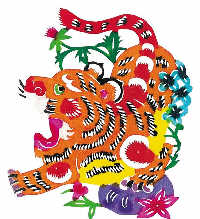
Papercuts refer to handicrafts made by cuttingpaperwith scissors to form different patterns and pasting them on walls, windows, doors and ceilings. With their long history, papercuts, which originated in China, have been very popular among the ordinary people of China. The first papercut can be traced back to theNorthern and Southern Dynasties(386-581) period. The initiation and spread of papercuts had a close relationship with Chinese rural festivals. People pasted papercuts on walls, windows and doors at wedding ceremonies or festivals to enhance the festive atmosphere.
Chinese papercuts are rich in content. The auspicious designs symbolize good luck and the avoidance of evil. The child, lotus and bottle gourd designs suggest a family with a large number of children and grandchildren. Domestic birds, livestock, fruit, fish and worms are also familiar objects depicted by Chinese farmers. There are some special papercuts of traditional design used as patterns for embroidering clothes,shoes, hats, pillows, bed curtains and door curtains. Papercuts made in different areas have different characteristics. Shaanxi window papercuts are simple and bold; papercuts fromHebei ProvinceandShanxi Provinceare bright in color; papercuts in southern provinces are delicate and fine.
Although papercuts are simple to make, their themes reveal many local Chinese customs. Papercuts typically demonstrate the preferred aesthetics of shape and the artistic concepts behind Chinese folk handicrafts. An understanding and scrutiny of papercuts is a good beginning to getting to know and appreciate the complexity of Chinese folk arts.
The art forms are mainly used as decorations and patterns for religious and ornamental purposes. Papercuts can also be used as ornaments on gates, windows, walls, columns, mirrors, lamps andlanterns. They are still widely used today at important festivals, especially during the New Year. It is very important to put papercuts at the entrance gates for good luck for the family. Papercuts can also serve as presents or as decorations on gifts and sacrificial offerings to the ancestors or gods. In addition, they can be used as embroidery patterns for clothes and lacquer works.